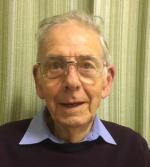
Rolls-Royce Conway
My time in the Special Projects Office in Derby
by Alistair Wright
Published 10 Feb 2019
 |
| Alistair Wright |
One bright autumn day in late August 1954 I cycled from my home in a Glasgow suburb to Rolls-Royce Hillington and made my way to the Personnel Department (HR these days) to commence my employment with the company. There were several others joining that day, some of them fellow graduates of what is now Strathclyde University. We had met with the 1953 intake of graduate apprentices at a jolly dinner hosted by R-R the previous week and an early indication of how well we were going to be treated by our new employer.
The signing on process did not take long, and I was issued with my security check – a rubber disc with a celluloid window which held my security badge. I had become S 3020. My first work place was to be the toolroom in ‘E’ block and I was collected by the foreman and shown where to hang my jacket as I climbed into my overalls. My previous work experience had been gained over three six month periods between semesters at university. I had spent one with British Railways in a locomotive repair outfit and two in the drawing office at the North British Locomotive Company designing steam locomotives. These last two periods turned out to be more significant than I could have guessed at the time. The contrast in working environments could scarcely have been greater. The oil soaked floors and dirt of the loco works were in stark contrast to the polished floors of the Hillington toolroom. The next big surprise was the extreme precision of the work. I had some understanding of metrology from college but the work being done in the toolroom was an order of magnitude more accurate. I soon became adept at using comparators, sine bars, and slip gauges and doing a lot of trigonometry using five-figure log tables. No computers or calculators in those days.
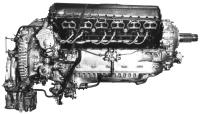 |
| The Rolls-Royce Merlin XX |
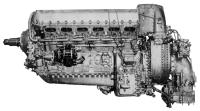 |
| The Rolls-Royce Griffon |
Graduates did a compressed course similar to an engineering apprenticeship, and you moved from shop to shop on a detailed program. Hillington only built and repaired piston engines, so I became very familiar with the Merlin and Griffon which were still in service with BOAC (the Argonaut – a civilianised Lancaster bomber!) and the RAF in a variety of roles. We even built a batch of Merlins for the Spanish Air Force, which were fitted to Heinkel 111 s (don’t ask). I covered all the major sub assemblies and also final build on Merlins ending up in the Experimental shop where piston-engine development work was still on going, and after building an engine you went to the test beds with it. One fine day we had an engine which was reluctant to start, but we kept turning it over till it fired - on full throttle, ran up to 3,000 rpm and threw its rods through the side of the crankcase. During assembly some one had turned the crankshaft while the camshaft drive for one bank was not connected; a big notice was hung up in the shop which said ‘Have you checked your timing’.
In June 1955 I was transferred to the factory at East Kilbride, then newly opened, to learn about jet engines. EK was a revelation to me as it had state of the art machine tools for making the complex parts for the Avon engine series which was in full production. I also had a short spell on the much simpler centrifugal Derwent and Nene engines. It was my first experience of machining magnesium alloy parts, the swarf from which was very prone to catch fire. Large buckets of chalk dust lay about the place to put these out.
 |
 |
 |
| Rolls-Royce Avon RA.3 (Bruce Vander Mark) |
Rolls-Royce Derwent (Al Charlevois) |
Rolls-Royce Nene (Jim Buckel) |
By the end of my time at EK I had completed the necessary 18 months on the shop floor which I would require later for Corporate membership of the I Mech E (equivalent to Professional Engineer, or PE) so I was moved to office jobs. I had a short spell in the nascent Diesel Engine Division which was having parts made at Hillington, mainly cylinder blocks and heads. It was intended that I should become a production engineer in that division, but fate stepped in and changed all that. I was suddenly moved to Piston Engine Performance to help out with some urgent calculation work going on there on the last marks of Merlin. The boss was a genial character called John Morgan and I worked for his assistant Ken Kinghorn on max take off weights in tropical conditions. Nairobi was the key airport, being both high and hot. I am not at all sure that JM did not have a hand in what happened next.
As 1956 wore on, my period of deferment from military service was coming to an end, and I prepared to join the RAF on a short service flying commission which was open to me as I had passed all the tests to join the University Air Squadron in my first year but had not been offered a place because my legs were too long for the Harvard trainer that they flew. R-R had other ideas. I was summoned to the Personnel Department one morning in May and informed that I was being transferred to Derby as an aircraft engine designer and was now permanently deferred from military service, so I could just forget about the RAF. I was handed a travel warrant and the address of the accommodation they had organized for me, and that was that. Someone in Personnel had obviously noticed on my application form that I had done 12 months drawing office time with the NBL. So on the 16th of June 1956 I ceased to be a GA, and became a designer in the Special Projects Office at Elton Road working for ‘Flap’ Fletcher. The special project was the Conway, the world's first turbofan.
 |
| Rolls-Royce Conway (Gary Brossett) |
The Special Projects Office in Elton Road was located in one of the wings of a building which had been built in 1938 as a hospital in anticipation of heavy civilian casualties in WWII, but for which it was fortunately never needed. The Conway Chief Designer A.H. ‘Flap’ Fletcher presided over this office helped by three Assistant Chief Designers, Nigel Payne, Frank Gordon, and Frank Stark. The two Franks were very nice men who went out of their way to encourage and help young graduates. Nigel Payne was just that – a pain. I think he had a chip on his shoulder and disliked graduates. I found myself allocated to the Conway Wheel Case under its genial section leader Dennis Chapman. Sometimes Dennis would survey your latest effort and with one eyebrow raised, enquire “would you trust your life to that young man?” This was enough to make you slink away and redesign the whole thing. Actually design was very painstaking and thoroughgoing, and no scheme was ever acceptable on just one attempt; in fact usually three versions would be done. Dennis was a truly outstanding designer and leader and I felt lucky to be one of his ‘boys’. I was always a good draftsman, a skill that I value greatly (no longer needed in these days of CAD) and which I learned at grammar school under a brilliant teacher. I collected all the prizes for Technical Drawing and it was starred in my school-leaving certificate. It meant that I was excused from the drawing class at University. Later leading design teams for most of my career, it was very useful to be able to do anything my subordinates had to do at least as well as they could. The senior men in the office were all very experienced; some went back to Sir Henry’s time, had worked on the cars and the early aircraft engines. There was one other ex GA in the section like me – Angus Thomson, a St Andrews graduate and fellow Scot two years older than me. He took me under his wing and very soon I was making good contribution to the work of the section. In 1958 Angus went to the USA to join Allisons, a company R-R eventually took over. Stewart Miller joined the office a bit after me and had the adjacent board. He went on to greater things! At one point we had six graduates all working on drawing boards all of whom held First Class Honours degrees. I think the American equivalent is Summa cum laude. Only Rolls-Royce could manage that.
The Conway in 1956 was still in its early stages of design and several new materials were coming into use. Titanium for one was totally new to all of us, and a tricky metal it turned out to be. Difficult to machine and impossible to weld we were told. The first Conways looked more like boilers with their riveted by pass ducts. Welding under an inert atmosphere, which avoided hydrogen embrittlement of the weld, was discovered soon after my arrival and Conway ducting thereafter took on its now familiar smooth appearance. Other developments like lost wax casting for turbine blades and spark machining were all pushing the boundaries of technology. And of course in those days computers were quite unknown; slide rules and nomograms were the tools we had, and pencils were the only means of making drawings.
The other wings at Elton Road housed the other engine design groups including the Dart and Tyne teams led by Geoff Wilde, Lionel Haworth and Fred Morley. Still other wings looked after gear and bearing design, stress, and standards, performance was located in other offices as well as a huge detailing organization in another building where the component drawings were prepared from our design schemes. You had to check these components from your design when they were complete, which might be some weeks after you had issued the scheme. One day I had a strange shaped part to check which I could not find anywhere on my scheme. It turned out that the hapless draughtsman had detailed some fresh air! He had at least put a question mark in the box for ‘material’. From time to time Lord Hives or AA Lombard would tour the boards, often on a Saturday morning. The first time Hives came round I didn’t know who he was, and it wasn’t until after he left that I found out. I guess I didn’t say anything career limiting!
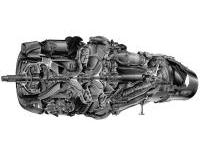 |
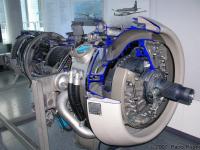 |
| Rolls-Royce Dart | Rolls-Royce Tyne (Paulo Pisani) |
As time went on the Conway became ever more complicated and heavier, and more thrust was needed for the aircraft it was to power, so more compressor stages were needed etc. It was like running up an elevator coming down, and the day came when Flap called us all together and said we had to get 150 lb of weight out of the engine and we would work all the overtime possible to achieve this. Six weeks later, after 60 hour weeks, there were few of us still standing but we did it. I went on from Wheel Cases to the Turbine section under Fred Freeman, another great designer, and then to the Thrust Reverser, a totally new feature on jet engines. We came up with a ‘clam shell’ design which came out of a brainstorming session one afternoon. I designed the actuator rams and linkage for that. I also designed a water methanol injection system which didn’t get incorporated. The Conway went through many block numbers and while we were designing it the people up at Sinfin were testing and developing it.
There was a spectacular failure of a Conway on Type Test one day when the HP compressor and HP turbine parted company. The turbine proceeded to overspeed and disintegrated, throwing blades and chunks of disc hundreds of feet into the air round the Test House. The inquest into that discovered that a tiny piece of slag in one stainless steel tube of the fuel cooled oil cooler had allowed fuel to slowly leak into the oil system to the point where the oil ceased to be a lubricant and the centre bearing had over heated, caught fire, and melted the HP shaft. The sight of that shaft twisted like a stick of liquorice will remain with me forever! I was in the test cell control room when this happened. I have never seen so many people hit the floor so fast!
So the three years I spent in Derby passed productively and very pleasantly. I became a senior designer, gained a tremendous amount of useful experience and made many friends in Special Projects. One of them, Ian Stratton, left the office in 1958 for a job with English Electric Stafford to set up a mechanical R&D operation and he asked me to join him in 1959, by which time I was beyond the age limit for National Service, and could leave R-R without risk of being called up. So I went to EE and spent ten years there finishing as Chief Mechanical Designer in the Large Industrial Machines Division. I was sorry to leave R-R but with 150+ other young men all with high quality degrees I was a small fish in a big pond and promotion seemed too dependent on luck. R-R tried to keep me but could make no firm promises. My subsequent career included machine tools, xerographic copiers, optical weapon sights and laser guidance for airborne weaponry. The training I had at R-R made all these transitions easy. I look back on my R-R days with affection. A great place to work with great people. The experience more valuable than any university degree.